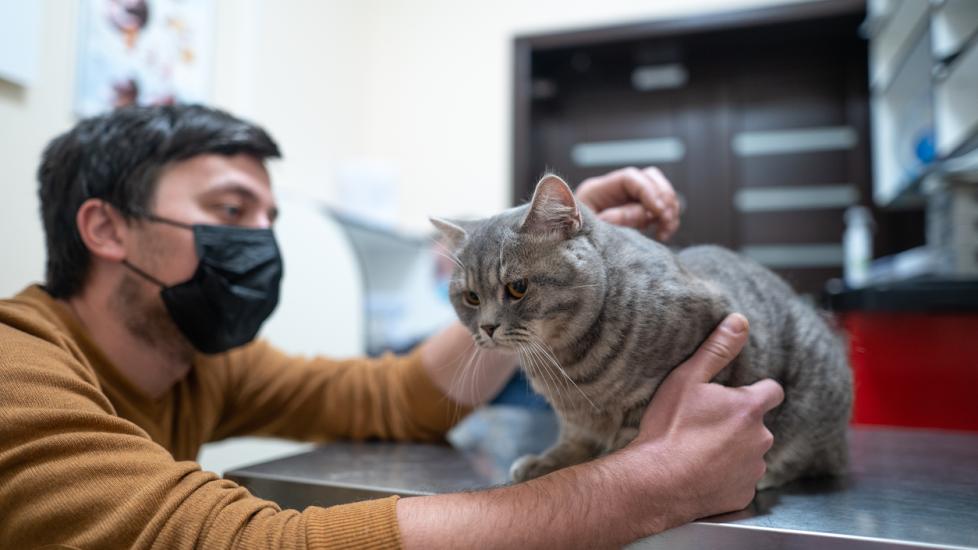Lymphadenopathy in Cats
What Is Lymphadenopathy in Cats?
Lymphadenopathy is the enlargement (swelling) of a single lymph node, a group of lymph nodes, or all lymph nodes. Lymphadenopathy is not a primary disease; it is a symptom of an underlying condition, such as lymphoma, a tick-borne illness, or another infectious disease. This enlargement of lymph nodes can happen quickly or gradually.
Lymph node swelling is most often noticed first in peripheral lymph nodes, those that can be felt under the skin:
-
On the neck
-
Behind the jaw
-
In front of the shoulders
-
In the armpits
-
In the inguinal (groin) area
-
Behind the knee joints
If you notice any new or growing swelling in these or any other areas of your cat’s body, take them to your veterinarian as soon as possible. Treatment is dependent on the underlying cause.
Symptoms of Lymphadenopathy in Cats
Other than lymph node enlargement, other symptoms depend on the underlying cause of the swollen lymph nodes. They include:
-
Cough
-
Lethargy
-
Poor appetite
-
Trouble eating
-
Labored/fast breathing
-
Regurgitation
-
Swollen limbs
-
Fever
-
Weight loss
-
Lymph node pain/heat
-
Lack of appetite
Causes of Lymphadenopathy in Cats
Lymphadenopathy can affect cats at any age. It is a reaction in the lymph nodes that can be caused by a virus, inflammatory condition, vaccine reaction, tick-borne illness, cancer, or other infection.
Cats that are not on tick preventatives are at a higher risk of developing this condition, due to their susceptibility to tick-borne illnesses. It is important to uncover the underlying cause of the lymph node swelling to decide on the right diagnostics and treatment needed.
Specific causes include:
-
Reactive hyperplasia—enlargement due to reaction to things like vaccines or immune-mediated disease
-
Lymphadenitis—enlargement due to reaction to things like bacterial infections, rickettsial infections, fungal infections, parasitic infections, and viral infections
-
Neoplasia—primary, such as lymphoma; or secondary, such as carcinoma, melanoma, sarcoma, or mast cell tumors
-
Rare causes such as edema
How Veterinarians Diagnose Lymphadenopathy in Cats
After your veterinarian examines your cat, the next step is for them to take a fine needle aspirate of any enlarged lymph nodes. This involves taking a small needle, inserting it into the lymph node, drawing out some cells, spreading these cells onto a microscope slide, and looking at them under the microscope. This is generally not a painful procedure and does not require sedation.
CBC, chemistry panel, and urinalysis, along with diagnostic imaging such as x-rays or CT scan, are often needed to find the underlying cause as well. Imaging can show the severity of disease by finding how large the lymph nodes are, if any internal lymph nodes are abnormal, or if anything else internally looks abnormal and points to an underlying cause. Cats should also be tested for feline leukemia virus and feline immunodeficiency virus (FIV), as these are typically underlying conditions causing lymphadenopathy.
If no cause is initially found, a lymph node biopsy may be needed. This sample would be sent out to a reference lab and processed to figure out what types of cells make up the enlarged lymph node, which would show a potential cause. Less commonly, more advanced testing may be needed.
Treatment of Lymphadenopathy in Cats
Treatment is dependent on the diagnosis of an underlying cause. Treatment could include antibiotics, antifungals, supportive care, chemotherapy, radiation, or surgery. For example, lymphoma could be treated with chemotherapy, tick-borne illnesses could be treated with antibiotics like, doxycycline, and supportive care/time in the case of vaccine reactions or viral infections.
Recovery and Management of Lymphadenopathy in Cats
Recovery and prognosis are largely dependent on the underlying cause and how progressive the disease is. For example, recovery for a tick bite infection would potentially be much quicker (maybe weeks to months) and less intense than recovery from an aggressive form of cancer (perhaps untreatable), both of which could cause lymphadenopathy.
Prevention of Lymphadenopathy in Cats
Most causes of lymphadenopathy are either acquired, infectious, or neoplastic, so unfortunately, there is nothing we can do to prevent these issues. However, tick-borne illnesses can also cause lymphadenopathy, so it is important to keep your pet current on monthly tick preventatives in order to prevent tick-borne illnesses such as Lyme, Babesia, anaplasma, or Ehrlichia.
References
-
Cohn L, Cote E. Dogs and Cats. Cote’s Clinical Veterinary Advisor, 4th ed., Mosby; 2020.
Featured Image: iStock.com/Yelizaveta Tomashevska
